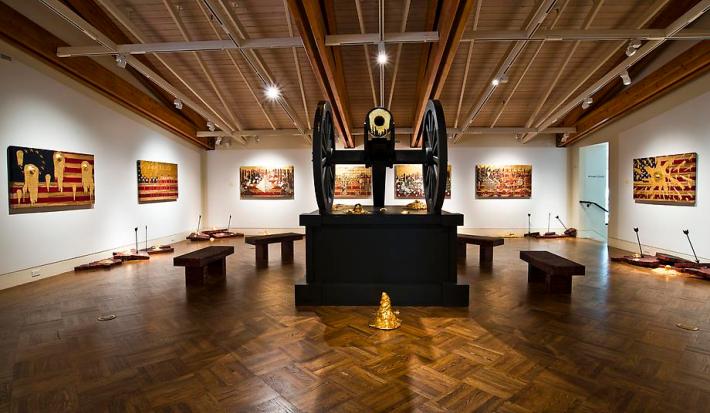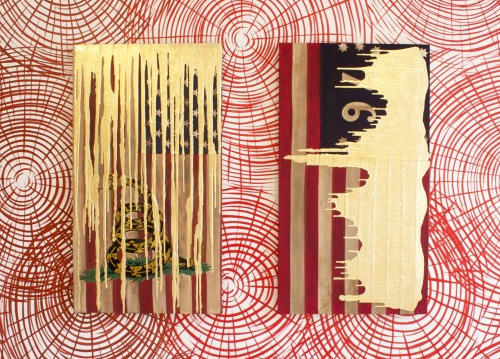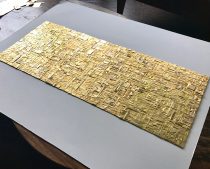first published in BlISSS Magazine, January 22, 2013
ANDREW SCHOULTZ @MARK MOORE GALLERY
by Matt Gonzalez
Politics permeates the work of artist Andrew Schoultz, a Wisconsin native living in San Francisco. His latest work appropriates the American flag, revered symbol of freedom and patriotism to many. He stretches military-grade flags and uses them as a canvas, which he covers in gold leaf and gobs of paint. Sometimes he covers the entire flag, leaving only the underlying texture of stars and stripes projecting through. At other times he covers only part, leaving a vestige visible. Schoultz presents a dialectic on the embedded symbolism of the flag, confronting both what it purports to represent versus its true nature.
Some will argue Schoultz is desecrating a symbol of liberty, yet he’s actually making a statement challenging patriotism. Schoultz’s flag paintings aren’t anti-American, but they tell an uncomfortable truth: the United States’ foreign and economic policies are ruining this planet. Schoultz doesn’t hesitate to treat these flags the way the government sometimes treats its people. Gone is any pretense of respect. A nation that falsely purports to embody freedoms must be challenged if it’s to transform into what Americans believe its symbols represent. Now the flag denotes poverty, diminished civil liberties, perpetual war, and environmental degradation. By exercising his right to speech and defending our lost democratic values, Schoultz’s flags are patriotic. They challenge the viewer to question to what extent imperialism and capitalism have undermined our republic.
Purchased from the official-sounding The United States Flag Store, Schoultz reveals that these military flags are actually made in China. The very emblem intended to evoke national pride is enmeshed in the politics of outsourcing. Some Americans may decry what they believe is an artist’s manipulation that defiles their symbol of national identity, while hiding a poignant truth—Americans won’t pay local workers decent wages even when manufacturing their own national flag. This political irony is what Schoultz’s work concerns.
Andrew Schoultz, “Horse with Chimney”, acrylic on wood, 10 1/2 x 10 1/2 inches.
In tandem with his flag paintings, Schoultz paints detailed narrative work for which he is best known. Dense paintings, layered with collage and printmaking elements, they are monumental, comprised of recurring motifs: galloping horses, tornadoes, pyramids with eyes hovering above, sky riddled with arrows, billowing clouds, all chronicling inevitable cataclysmic events if the U.S. continues its damaging policies. Schoultz’s illustrations are part history, part prophecy. The work portrays a contemporary drama ranging from natural calamities to the man-made collapse of the global economy. Schoultz provokes a meditation on U.S. war-waging, and the devastating consequences capitalism delivers, evidenced by the continued military presence in Western Asia and effects of global warming.
Through a chorus of repeated symbols, Schoultz presents nondescript narratives of collapsing empire. Trade deficits, bank failures, and our debt crisis, all underscore an alarming truth: China owns an unprecedented $5 trillion worth of the U.S.’s debt, marking a shift in global economic supremacy.
Viewers must decide how to read Schoultz’s political narratives. For some, it’s simply aesthetically pleasing. For others, it’s an incendiary narrative by an artist who tells it like it is. Schoultz succeeds because his canvases can read literally or metaphorically. Some see gallant horses striding about, others rider-less warhorses galloping amidst a barrage of arrows, as if a medieval army had skirmished.
Somewhere there is a better world. For the time being, Schoultz isn’t painting it.
Fall Out opens at Mark Moore Gallery in Los Angeles on January 12.
 Andrew Schoultz: In Process, Monterey Museum of Art, 2013.
Andrew Schoultz: In Process, Monterey Museum of Art, 2013.

Andrew Schoultz: Ex Uno Plura, Eric Firestone Gallery, East Hampton, NY, 2012.




